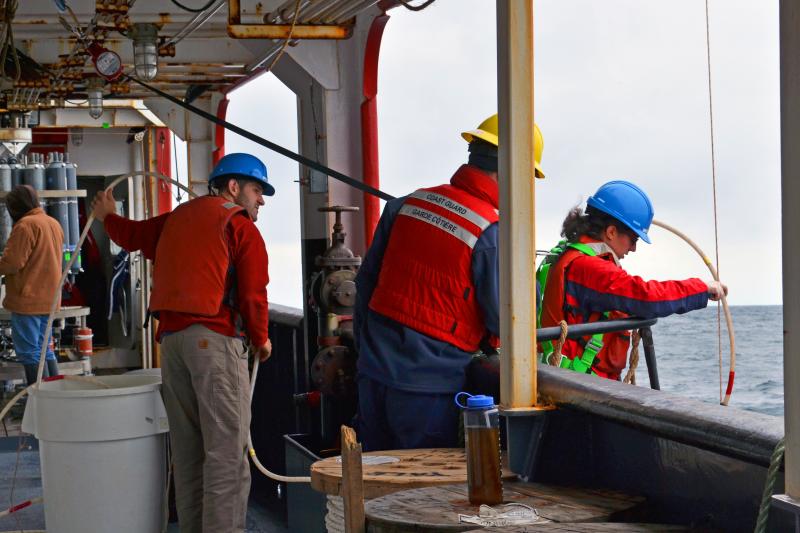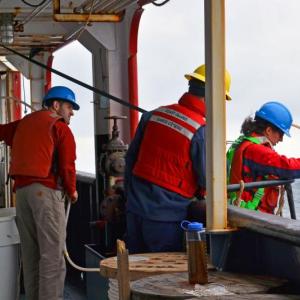Research unlocks secrets of iron storage in algae
 Study authors Ben Twining and Natalie Cohen collect water samples in order to study the phytoplankton communities within. The researchers found that phytoplankton iron storage strategies may determine which species thrive in changing oceans and impact marine food webs. Courtesy of Bigelow Laboratory for Ocean Sciences
Study authors Ben Twining and Natalie Cohen collect water samples in order to study the phytoplankton communities within. The researchers found that phytoplankton iron storage strategies may determine which species thrive in changing oceans and impact marine food webs. Courtesy of Bigelow Laboratory for Ocean Sciences
 Study authors Ben Twining and Natalie Cohen collect water samples in order to study the phytoplankton communities within. The researchers found that phytoplankton iron storage strategies may determine which species thrive in changing oceans and impact marine food webs. Courtesy of Bigelow Laboratory for Ocean Sciences
Study authors Ben Twining and Natalie Cohen collect water samples in order to study the phytoplankton communities within. The researchers found that phytoplankton iron storage strategies may determine which species thrive in changing oceans and impact marine food webs. Courtesy of Bigelow Laboratory for Ocean Sciences
New research shows that phytoplankton iron storage strategies may determine which species thrive in changing oceans and impact marine food webs, according to a recent paper in the Proceedings of the National Academy of Sciences. The research examined two primary methods of iron storage and found that one makes species more resilient against shortages of the rare and essential element.
“The ability of phytoplankton to store iron drives important chemical cycles and shapes the ecology of the entire ocean,” said author Ben Twining, a senior research scientist and the Henry L. and Grace Doherty Vice President for Education at Bigelow Laboratory for Ocean Sciences. “If we want to understand how the oceans will respond to climate change, we need to understand the iron cycle.”
The study focused on diatoms, single-celled algae that live inside glass shells and are one of the most bountiful groups of phytoplankton. A secret of their success, Twining believes, is how well they store iron, a critical nutrient that is scarce in 40 percent of the global ocean. Diatoms stockpile iron by two main methods: storing the molecules in a bag-like organ called a vacuole or chemically locking them away in the protein ferritin.
The researchers found that diatoms that use ferritin have a real edge over competitors. Iron tends to enter impoverished areas in pulses, rustled up by storms that reach down and stir up deep iron-rich waters, or wind that carries dust from far-off lands. A microscopic feeding frenzy then ensues: phytoplankton snatch up the iron and use it to rapidly multiply. The team found that diatoms who make ferritin were able to utilize these times of plenty to prepare for the prolonged periods of iron starvation that follow.
“The more nuts a squirrel can store, the more likely it is to survive lean times,” Twining said. “We think that the same process is true with phytoplankton and iron.”
As climate change shifts the geography of iron in the global ocean, some areas will become poorer in iron - which sounds like good news for diatoms that make ferritin. Favorable conditions could help them outcompete other types of diatoms, ultimately influencing food webs in the ecosystems they live in and even large ocean cycles.
The researchers arrived at these conclusions through novel methods. Professor Adrian Marchetti's team at the University of North Carolina Chapel Hill used advanced sequencing technologies to observe what happened to the diatoms' gene expression when faced with a pulse of iron, while Twining's group measured the amount of iron inside individual cells.
“The way this study connects molecular and biochemical measurements to reveal the behavior of individual species in a natural phytoplankton community is quite rare and hopefully the way of the future,” Twining said. “I think this is a new wave of oceanography that can show how phytoplankton communities shape the ocean.”
Event Date
Address
United States






















